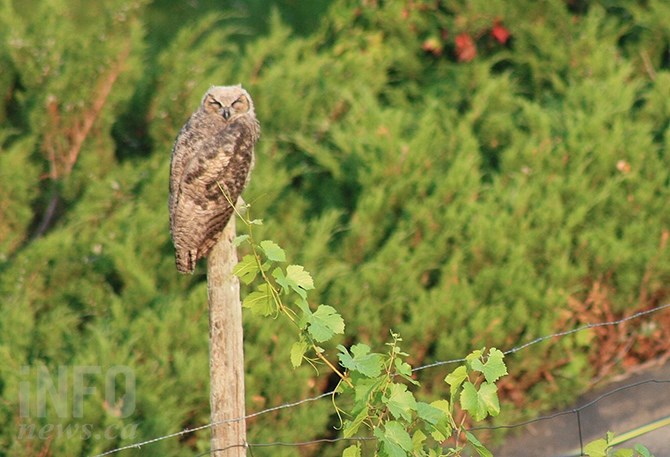
The Okanagan is home to several different species of owl, but the most common is the Great Horned Owl.
(STEVE ARSTAD / iNFOnews.ca)
August 21, 2018 - 6:00 PM
PENTICTON - You don’t often see them since they are most active at night, but if you live near them, you’ve likely heard their familiar calls through the Okanagan’s warm summer nights.
South Okanagan Rehabilitation Centre for Owls Manager Dale Belvedere says of B.C.’s 15 owl species, the one most common to the Okanagan is the Great Horned Owl.
Grey-brown in colour, Great Horned Owls are between 45 and 64 cm, with a wingspan of 114 cm and weight of 1.5 to 2 kilograms.
Great Horned Owls are found throughout the Okanagan’s timbered areas. They also make homes in residential areas, on golf courses, parks and vineyards.
The Great Horned Owl makes a distinctive call of three hoots, and generally lives for between 15 and 20 years.
Owls mate for life, usually in February, laying around three eggs three days apart in nests they’ve taken over from other birds.The young are born in mid-March.
Owls are most active during mating season. By mid-summer, the babies have left the nest, but parents continue to keep an eye on their offspring for three months.
Owls have a 30 per cent higher capacity for hearing than humans, able to detect prey by sound even under two feet of snow. Their ears are located behind their eyes, which are fixed.
The birds are capable of turning their heads 270 degrees.
Of all the bird’s senses, smell is their least reliable.
An owl’s search for food involves preying on rodents and small birds, often found in vineyards, farms, parks and residential areas. They are helpful in controlling rodent populations, and their main predators are larger species birds such as eagles or hawks.
Belvedere says pet owners shouldn’t lose too much sleep over fears of owls taking their cat or dog, but there is always an exception to the rule.
“Cats and dogs are not their preference, however if there is a lack of food supply it has been known to happen. They can lift a small dog or cat of approximately 10 pounds,” Belvedere says.
The Okanagan is home to a number of other owl species, most notably the northern pigmy, the smallest owl in B.C., with a height of 36 to 41 cm and a wingspan of 84 cm. They are commonly seen in the Apex Mountain area in the winter months.
Other Okanagan owls included the Saw-Whet, Western Screech, Barred and Barn owl.
Summer wildfires and smoky Okanagan skies don’t bother the birds. Belvedere says owls cool down by “fluffing up.”
“We have never had an increase in owls at the rehab centre due to smoke,” she says.
To contact a reporter for this story, email Steve Arstad or call 250-488-3065 or email the editor. You can also submit photos, videos or news tips to the newsroom and be entered to win a monthly prize draw.
We welcome your comments and opinions on our stories but play nice. We won't censor or delete comments unless they contain off-topic statements or links, unnecessary vulgarity, false facts, spam or obviously fake profiles. If you have any concerns about what you see in comments, email the editor in the link above.
News from © iNFOnews, 2018